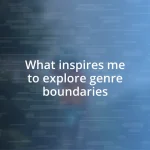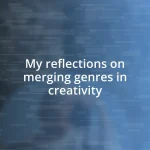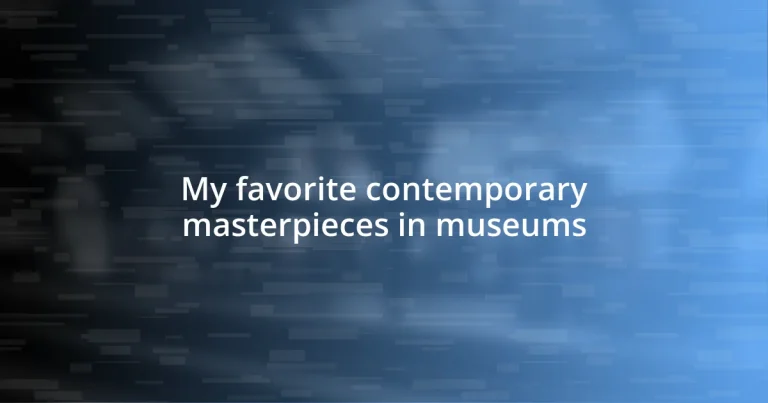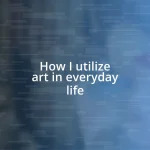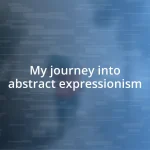Key takeaways:
- Contemporary art reflects current culture, technology, and social issues, encouraging personal reflection and dialogue among viewers.
- Notable museums like MoMA, Tate Modern, and Centre Pompidou showcase exceptional contemporary artworks that engage viewers with critical themes.
- Appreciating contemporary art involves curiosity, openness to new interpretations, and connecting personal emotions with the artwork’s message.
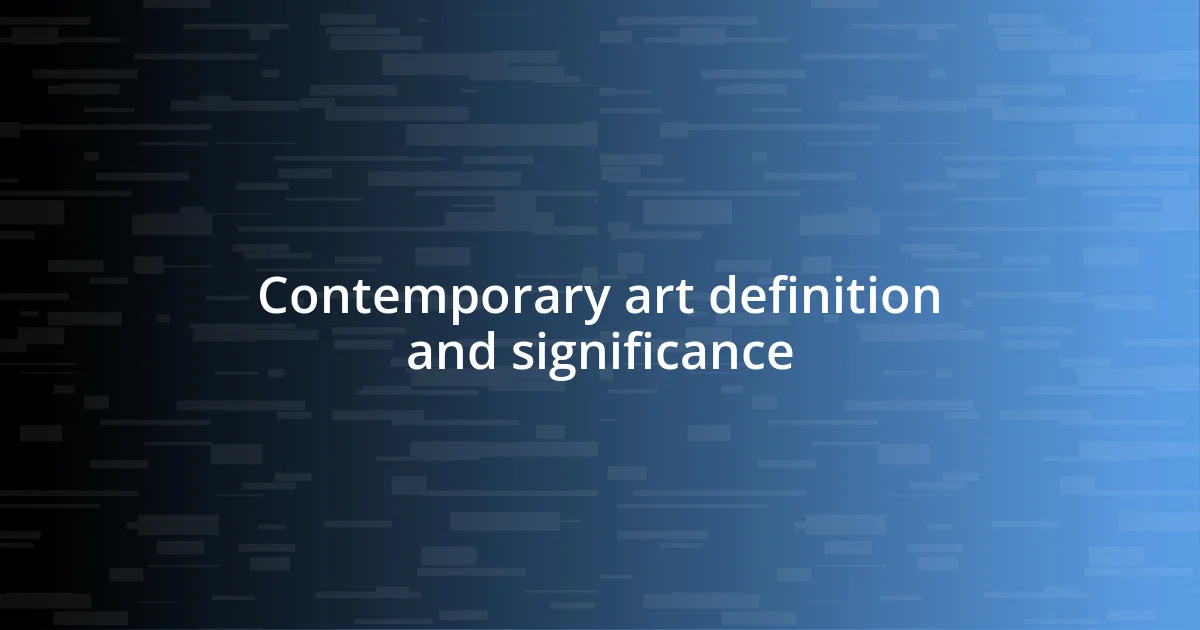
Contemporary art definition and significance
Contemporary art is often defined as art created in the late 20th century and into the 21st century, reflecting the current culture, technology, and social issues of our time. I remember my first encounter with a contemporary piece that left me questioning everything—an installation that challenged societal norms and made me think deeply about my own beliefs. Isn’t it fascinating how art can provoke such personal reflection?
The significance of contemporary art lies in its ability to mirror the complexities of our world. It invites us to engage with pressing issues like identity, globalization, and the environment. I often find myself standing in front of a thought-provoking modern work, wondering how the artist’s experiences parallel my own. Can you feel that connection too?
Contemporary art fosters dialogue and challenges our perceptions, encouraging viewers to explore beyond the surface. Each piece can evoke a unique response—sometimes joy, sometimes discomfort. I recall a vibrant mural that sparked a lively conversation among strangers who had different viewpoints. How has a piece of contemporary art changed the way you see things?
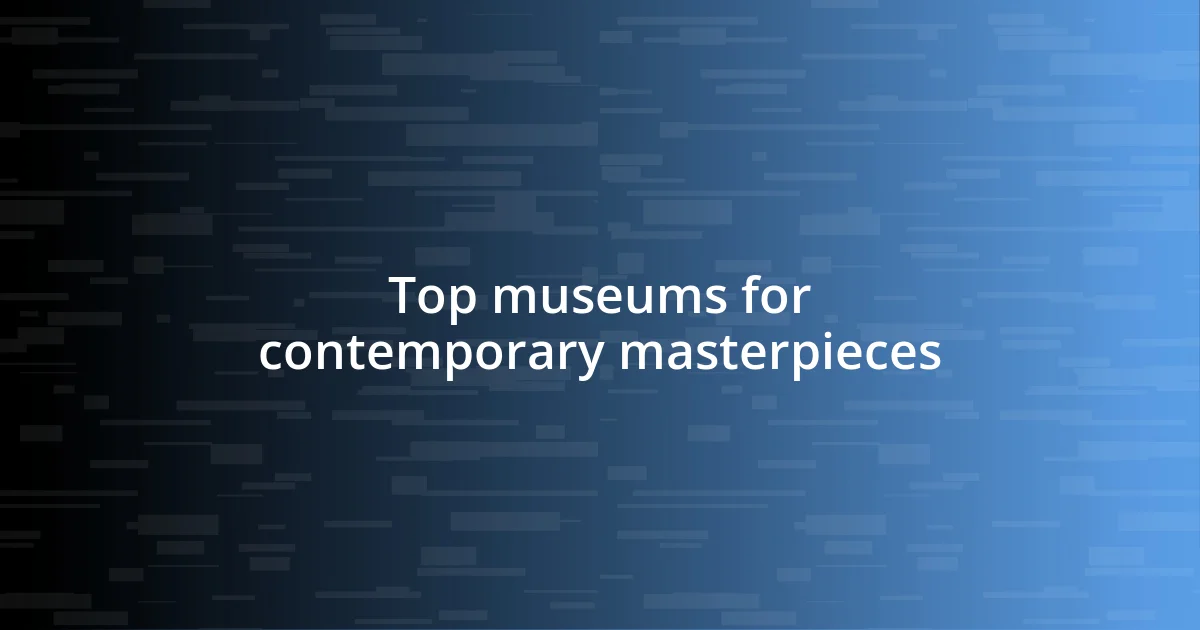
Top museums for contemporary masterpieces
When it comes to contemporary masterpieces, several museums stand out as leaders in showcasing remarkable and thought-provoking art. For instance, the Museum of Modern Art (MoMA) in New York is a treasure trove of innovation. I remember wandering through its expansive galleries, captivated by works that challenged my perception of reality. The way each piece interacts with the viewer creates an unforgettable experience, wouldn’t you agree?
Another gem is the Tate Modern in London, known for its bold architectural presence and stunning collection. I was particularly struck by an installation there that incorporated everyday items to explore consumerism—a powerful reminder of our relationship with material culture. The ambiance of the museum itself enhances the experience, allowing visitors to reflect deeply on the art. Have you felt a space amplify the impact of artwork in a similar way?
The contemporary art scene flourishes at the Centre Pompidou in Paris, which is famous for its avant-garde exhibits. I distinctly remember my time there watching visitors react to a vibrant multimedia exhibit; it underscored how contemporary art dialogues with culture across different spectrums. Each museum, rich in its offerings, invites a unique exploration of contemporary masterpieces, making it worthwhile to visit each one.
| Museum | Highlights |
|---|---|
| MoMA, New York | Renowned for modern paintings, sculptures, and installations from influential artists. |
| Tate Modern, London | Features a vast collection of contemporary artworks in a transformed power station. |
| Centre Pompidou, Paris | Showcases avant-garde collections and multimedia exhibits, emphasizing interaction with culture. |

Notable contemporary artists to explore
Exploring contemporary art is truly a journey, and several notable artists make that journey memorable. Their works resonate emotionally, often speaking to universal themes of identity, resilience, and innovation. For example, I recall visiting a gallery where Yayoi Kusama’s polka dot installations enveloped the room, making me feel both exhilarated and introspective as I pondered themes of infinity. Her unique vision invites viewers into her world, urging us to confront our own existence within the vastness of space and time.
Here’s a list of a few contemporary artists worth exploring:
- Yayoi Kusama: Known for her immersive installations and polka dots, she delves into themes of obsession and self-identity.
- Ai Weiwei: A provocative artist whose work challenges politics and human rights, often using installation art to convey social messages.
- Kara Walker: Renowned for her powerful silhouettes that explore race, gender, and history, prompting deep reflection on societal narratives.
- Banksy: The enigmatic street artist whose thought-provoking pieces often blend humor with commentary on politics and culture.
- Jeff Koons: Famous for his large-scale sculptures that comment on consumerism, I felt both amused and challenged by his take on what art can be.
Every encounter with these artists feels like an opportunity to explore different facets of our collective human experience. It’s intriguing to consider how their paths and perspectives mirror our own, don’t you think?

Highlighting key contemporary artworks
Highlighting key contemporary artworks is essential for understanding the evolution of modern art. I’ll never forget my first encounter with Damien Hirst’s “The Physical Impossibility of Death in the Mind of Someone Living.” Standing before that suspended shark in formaldehyde, I felt a mix of awe and discomfort. It provoked a visceral reaction, prompting me to think about life, death, and the boundaries of art in ways I never expected.
Another striking piece that captivated me was Olafur Eliasson’s “The Weather Project” at Tate Modern. Do you remember a time when you were enveloped in a work that completely shifted your perception of the space around you? I recall the entire room bathed in a warm, artificial sun, creating a collective experience where strangers shared the same dream-like state of reflection. This installation transformed the mundane into something magnificent, inviting dialogue about our connection to nature.
Then there’s Ai Weiwei’s poignant installation, “Sunflower Seeds,” displayed at the Tate Modern as well. The sheer scale—over 100 million handcrafted porcelain seeds—left me speechless. It symbolizes the power of the individual within the collective, don’t you think? Walking through the exhibit, I found myself contemplating the balance of individuality and community, examining how art can weave together personal stories with broader social narratives. Each of these contemporary masterpieces not only enchants but also challenges us to delve deeper into our understanding of art and its societal impact.
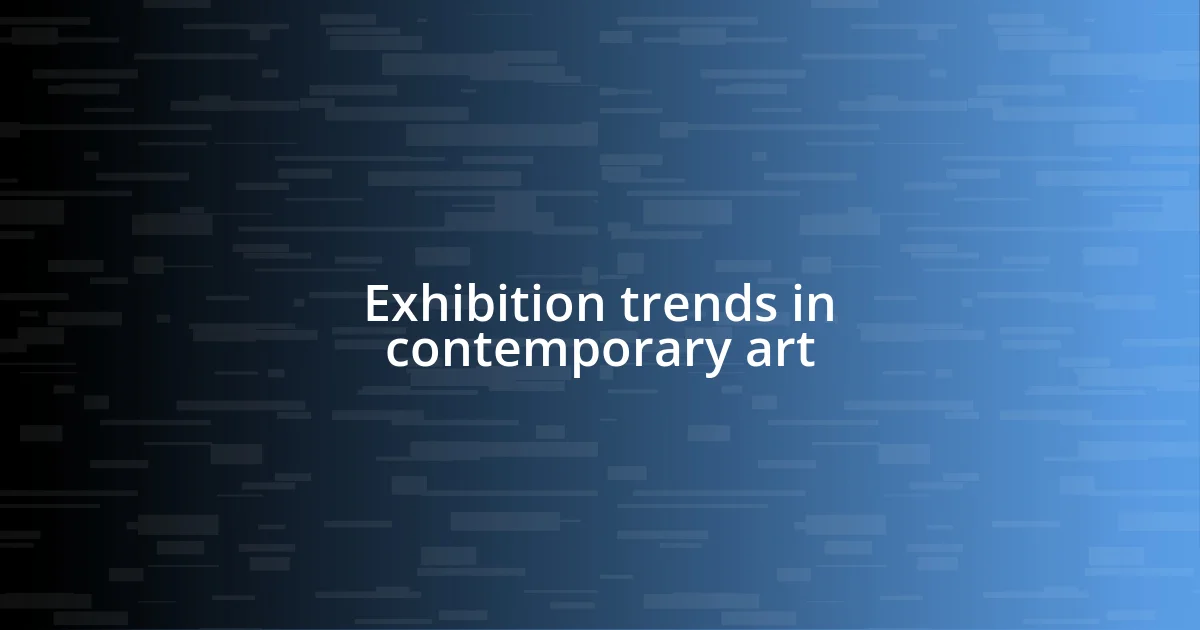
Exhibition trends in contemporary art
One interesting trend I’ve noticed in contemporary art exhibitions is the rise of immersive experiences that blur the lines between viewer and artwork. I remember stepping into the luminous world of TeamLab at a recent exhibit, where digital projections transformed the space into a living environment. It felt as if I was not just observing art, but also participating in a vibrant conversation with it. Doesn’t it make you wonder how these experiences challenge our traditional notions of what art is?
Another noteworthy trend is the increasing intersection of technology and art. I recently attended a show featuring augmented reality sculptures that sprung to life through my smartphone. Watching static pieces become dynamic was nothing short of magical, evoking a sense of wonder that kept me engaged. How fascinating is it that artists are now incorporating the very tools that define our digital lives into their work, urging us to reevaluate our relationship with both technology and creativity?
Additionally, the focus on social issues has become prominent in contemporary exhibitions. I was deeply moved by an installation addressing climate change, where the artist created a stunning visual representation of melting glaciers. As I stood there, I felt a profound urgency to reflect on my own impact on the environment. Isn’t it powerful how art can serve as a catalyst for change, encouraging us to confront pressing societal challenges? Each exhibition I visit seems to echo this call for awareness, prompting conversations that extend far beyond the walls of the gallery.

Visiting tips for art lovers
When you’re planning a museum visit, timing can make a significant difference. I’ve found that early mornings or late afternoons draw smaller crowds, allowing for a more intimate experience with the art. Imagine standing before a masterpiece with no distractions, fully absorbing the artwork’s details and emotions. It’s in those quiet moments that the magic of art truly unfolds.
Another tip I swear by is to take a moment to read the labels and descriptions accompanying the artworks. I remember a time when I rushed past a sculpture, only to discover later that it was part of a series commenting on mental health. That context transformed my perspective entirely. Engaging with the artist’s intention can drastically enhance your appreciation and understanding, making the experience much more meaningful.
Lastly, don’t hesitate to interact with museum staff or fellow visitors. I’ve had some of my best conversations with other art lovers right in front of the pieces that moved us. Have you ever found that your thoughts evolve through discussion? Sharing insights can deepen your understanding and create connections that extend beyond the gallery. So, whether you’re marveling at a large canvas or examining a delicate installation, remember that the art of conversation can enrich your museum experience just as much as the art itself.
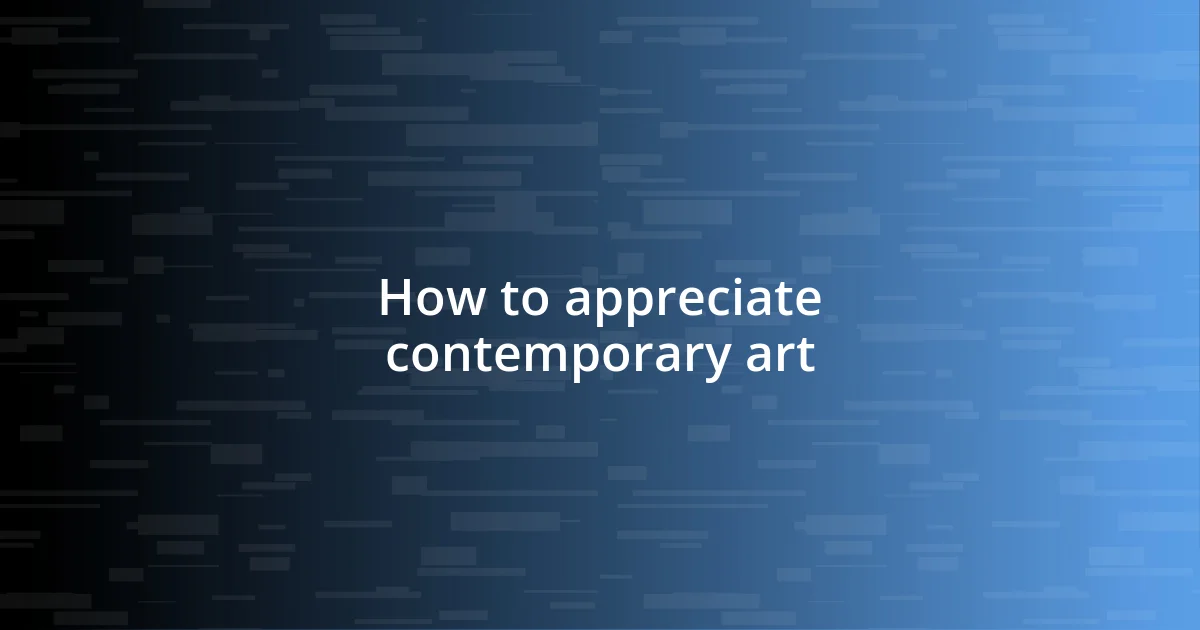
How to appreciate contemporary art
Appreciating contemporary art can often feel daunting, but I’ve learned that approaching it with curiosity is key. During a visit to a contemporary gallery, I found myself drawn to a piece that initially seemed chaotic and confusing. As I stood there, allowing the colors and forms to wash over me, I began to feel the emotions the artist poured into it. Isn’t it intriguing how taking a moment to sit with discomfort can sometimes lead us to deeper appreciation?
I also believe that it’s essential to let go of preconceived notions about art. I remember the first time I encountered a large, blank canvas. At first, I thought, “What’s the point?” But as I learned about the artist’s intention behind that emptiness—exploring themes of absence and presence—I started to appreciate the courage it takes to create something that challenges us. Have you ever felt similarly? Sometimes, the most profound insights emerge from works that at first glance seem underwhelming.
Finally, I encourage you to engage your emotional responses to art. When I observed a haunting installation depicting personal narratives of loss, I couldn’t help but reflect on my experiences with grief. It’s in those moments of connection that art becomes a mirror, inviting us to explore our own stories. Have you experienced that kind of resonance? Recognizing your emotions in relation to contemporary pieces can transform your encounter, making it not just an observation, but a meaningful dialogue between you and the artwork.




